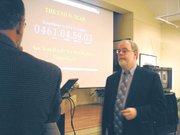Beverly Tatum’s favorite television show is "The Bachelor," but she’s not sure she’ll be able to watch it after Feb. 17, 2009. That’s the date old fashioned radio-wave transmission of all broadcast network shows will cease — pushing television viewers into a brave new world of digital broadcasting.
Seizing an opportunity millions of other Americans will have, she plans to get a $40 coupon toward the purchase of a converter box. After a presentation from a Federal Communications Commission official at the Alexandria Black History Museum last week, Tatum was so encouraged by the crisp definition of digital broadcasts and the promise of "multicast" channels available to each broadcaster that she thought the 2009 date might mark an important transition for her.
"If I could get one of these converter boxes and ditch cable, I’d be the happiest camper in the world," said Tatum, who lives in Alexandria. "I don’t watch most of the channels on cable as it is, so this would simplify my life a great deal."
During a demonstration by the FCC official, the participants in a public forum on the analog-to-digital transition first experienced the old fashioned radio-wave broadcast transmission. Channels were snowy, with "ghost" images tracing across the screen. Some channels were barely visible. Then the demonstration television was outfitted with a converter box, which allowed the set’s rabbit ears to pick up the digital broadcast transmissions.
"This is not like the old radio waves you learned about in school," said David Rumelt, a senior outreach advisor with the FCC, waving his hand in the air to simulate a wave motion. "These are a bunch of ones and zeroes flying through the air."
ALTHOUGH EACH digital station has the option to "multicast" up to six different broadcasts for each channel, few broadcasters are currently taking full advantage of the technology. Public broadcasting networks are leading the way, using their multicast channels for a variety of uses. During the FCC demonstration last week, multicast options on Arlington-based WETA included much more than the regular programming available on Comcast. Multicast digital channels available in a broadcast-only format included a number of options, including children’s programming, a cooking show, a historical documentary and a musical performance.
"Some of the local network channels are using their multicast channels to show radar weather maps," said Rumelt. "This is a technology that has a lot of promise, and it’s one area of digital broadcasting that people haven’t fully realized how it will be used."
Congress mandated the conversion to all-digital television broadcasting in 2005, and the bill was signed by President George W. Bush in 2006. In addition to the consumer options created by multicasting technology, the transfer to digital-only broadcasting will free up a significant number of frequencies that can be used for public-safety uses such as police, fire and emergency rescue. Those frequencies not used by public-safety officials will be auctioned off for the next generation of wireless services.
"One of the things we learned on 9/11 was that many of our public safety officials were not using the same frequencies," said Rumelt. "After television stations free up the frequencies used in the analog transmissions, public safety officials will be able to better coordinate communications."
CABLE SUBSCRIBERS won’t have to worry about the transition, say representatives from Comcast. Even after Feb. 17, 2009, Comcast officials say, the provider will continue to offer analog and digital subscriptions — although they say that the more expensive digital subscriptions will have crisp pictures with more definition. The broadcast channels will continue to appear in the cable station lineup, and existing customers will not have to buy a new television or a conversion device to watch them. Even those with analog television sets will still be able to watch cable television after Feb. 17, 2009.
"As long as our subscribers are hooked up to cable, they won’t need to do anything," said Lisa Altman, a spokeswoman for Comcast. "Our customers don’t need to worry about the transition."
FCC officials say that they are particularly concerned with reaching out to populations that are not traditionally cable subscribers, such as the elderly, minority groups and people who speak English as a second language. That’s why much of the FCC’s outreach effort has been coordinated through groups such as the Alexandria branch of the National Association for the Advancement of Colored People, which organized last week’s forum. Yet organizers admit it’s a daunting challenge to reach people who watch broadcast television.
"It’s tough," admitted S. Howard Woodson, president of the Alexandria NAACP. "No matter what you do, there are going to be people out there who turn on their television sets one day to find it’s gone blank."
